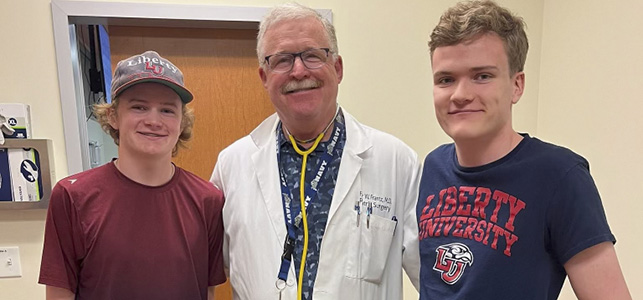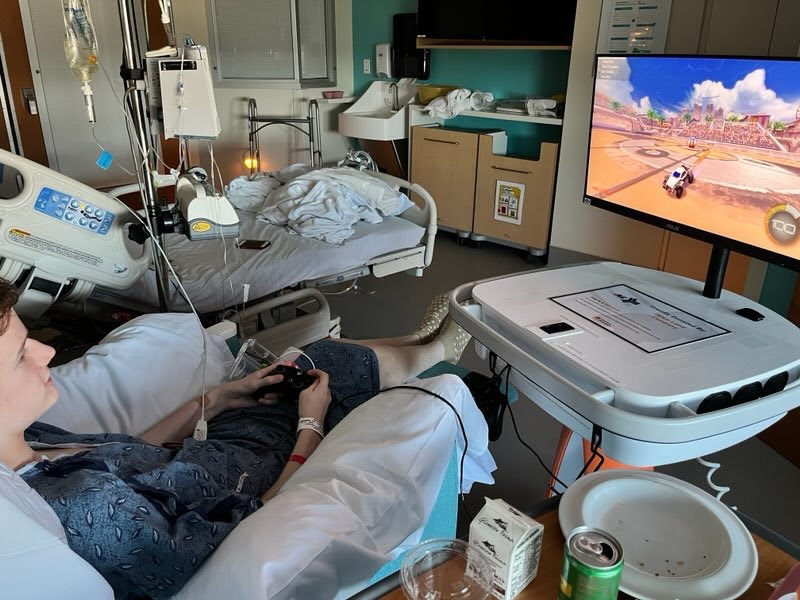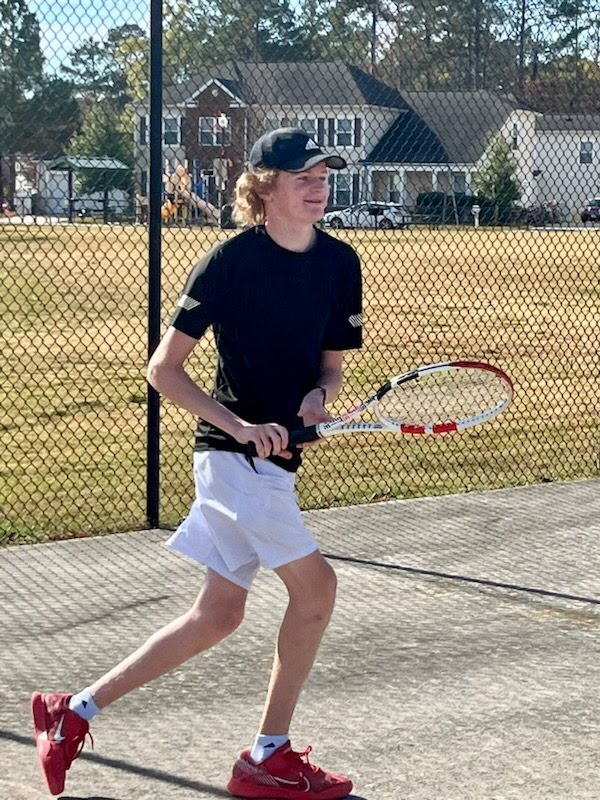
Rocky and David Holsinger receive pectus carinatum correction with Dr. Frazier Frantz at CHoR
Rocky Holsinger had the most severe case of pectus carinatum, or protrusion of the chest wall, his pediatric surgeon in South Carolina had ever seen. The surgeon referred the 15-year-old to Dr. Frazier Frantz, who specializes in the complex and intricate nature of chest wall surgeries.
“He said, ‘Dr. Frantz is one of the best in the world for this type of surgery…You’re going to be in great hands,’” said Rocky’s mom, Kari.
The timing was fortuitous. The Holsingers, a military family, were getting ready to relocate to Virginia, not far from Richmond where Dr. Frantz had recently joined the surgery team at CHoR. Rocky and his older brother David – who had a slightly less severe case of the same condition – met with Dr. Frantz that summer.
Watch the Holsinger family’s story
Finding the chest wall expert they needed
 “He really patiently answered all of our questions, and the questions the boys had, and we felt like we were very well aware of the plan and the outcome and what we were going to be facing,” Mom added about Dr. Frantz. “He was fantastic and he’s got a great sense of humor too.”
“He really patiently answered all of our questions, and the questions the boys had, and we felt like we were very well aware of the plan and the outcome and what we were going to be facing,” Mom added about Dr. Frantz. “He was fantastic and he’s got a great sense of humor too.”
As teens, Rocky and David still had soft cartilage. Growing into adulthood, the cartilage would become hard bone. Without corrective treatment, they were likely to deal with pain and stiffness in the chest and back, as well as impacts to cardiorespiratory function.
“The Holsinger boys had a rare connective tissue disease and complex chest wall deformities. There was a particular asymmetry to their deformities because of some congenital abnormalities with how their ribs were formed,” explained Dr. Frantz. “We treat that with an open repair where we remove the abnormal cartilages and realign the sternum in a flat orientation.”
In Rocky’s case, the 5-hour operation involved removing the cartilage from 14 ribs, fracturing and realigning the sternum, and putting in titanium plating to hold it all together while regrowing.
Despite some previous nerves – “It was just such a huge surgery” – Rocky was ready come operation day.
“It’s so reassuring to me, especially since I had such a severe case, knowing that this is the best possible care that I can receive. Dr. Frantz answered any questions or concerns I had and I just felt relaxed and confident in his abilities to perform the surgery,” he said.
Rocky’s road to recovery started in the Children’s Tower
Rocky recovered in the Children’s Tower for 5 days following surgery. The sports-loving tennis player isn’t used to sitting still for long, but he was able to watch the U.S. Open and play Xbox to pass the time.
“The staff was all great and the food was phenomenal,” said Rocky.
Recovery continued with help from Mom and Dad at home. After surgery, rib cartilage grows back in about 3 weeks. This is a unique characteristic in kids, underscoring the benefit of having this surgery before adulthood when regrowth takes much longer. It took several more weeks for his abs to heal and the ribs to get stronger.
 “Our goal is to put things back where they belong and allow them to stay there while kids continue their growth,” added Dr. Frantz. “For the open repairs like Rocky and David, we will follow them and restrict their activity with no heavy lifting or contact sports for 3 months. That’s generally to make sure that the ribs return to normal function and stability after they’ve regrown.”
“Our goal is to put things back where they belong and allow them to stay there while kids continue their growth,” added Dr. Frantz. “For the open repairs like Rocky and David, we will follow them and restrict their activity with no heavy lifting or contact sports for 3 months. That’s generally to make sure that the ribs return to normal function and stability after they’ve regrown.”
Rocky was thrilled to reach the 3-month mark and get the all clear to return to the tennis court. David’s surgery was up next. He got some good advice and encouragement from his brother who had already been through it.
David’s healing was excellent as well. He returned to college shortly afterward to continue his engineering studies.
Care for every chest wall condition, common or complex
Dr. Frantz also treats patients with the more common pectus excavatum, or sunken chest. This is usually done through a minimally invasive Nuss procedure to place a metal support bar in the chest, reversing its sunken appearance. Less severe cases of pectus carinatum and excavatum can be treated with non-surgical options such as bracing.
In Rocky’s and David’s cases, they’ll follow up with Dr. Frantz for the foreseeable future.
“In our practice, we see kids with complex chest wall deformities and connective tissue diseases, like Rocky and David. These kids with complex conditions need close surveillance to ensure that their repairs will stand the test of time as the chest wall remodels itself during adolescence and early adulthood,” said Dr. Frantz. “We’re fortunate to see patients from around the country who have heard about our services through word of mouth. These families place a lot of trust in us, and we’re immensely grateful for the opportunity to care for them and witness the improvement in their quality of life after chest wall reconstruction."
The Holsingers are among those who recommend Dr. Frantz every chance they can.
“My wife is a good researcher so she had done some research on Dr. Frantz and he had a lot of glowing reports from people that had seen him before. We experienced the exact same thing,” said Dad, Robert. “His bedside manner is amazing. His competence in what he does breeds trust in his abilities. He has just been phenomenal in his care for our family, but also his technical expertise.”
Rocky agrees.
“Knowing how bad my deformity was, it just feels good to have it be normal now.”
